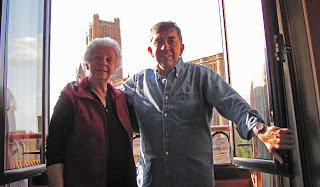

The picture of the chocolate therapy shop window in St. Malo might not fit anywhere else, so I put it in here. You gotta admit that chocolate therapy is a good reason to take a picture.
I didn’t take a lot of pictures, partly because the batteries didn’t last long and I worried they would be gone just as an important something came along. I kept buying replacements, but never enough. Also, I didn’t know how many pix the card would hold (many hundreds more than I thought). And also, to Mary’s chagrin, I simply didn’t want to film every little thing. I know I should have, but I reasoned that you could find it online or on postcards so why should I duplicate tourist shots. Dumb reasoning, because I now I wish I could show people the weird and wonderful non-tourist things. Had I known the card was practically endless, maybe I would have given in. Often, though, I enjoyed using my eyes to see with instead of the camera.
Anyway, a couple of times when I knew Mary was ready to explode, I gave her the camera and let her shoot away. Probably should have done more of that. Can I use as an excuse that the first time we went, we didn’t have a camera and didn’t miss it? No, because digital cameras have taken the tediousness out of carrying camera, lenses, and film.
On the other side of the coin are the Japanese tourists who only see with their cameras. At Versailles some were shooting every detail in a grand room without really noticing it themselves. I guess they’ll put it together when they get back home.
OK, back to the blog.
We boarded the train in Carcassonne, hefting our backpacks up the ladder and down the aisle. There are overhead racks high enough up that lifting the backpacks can be a weightlifting exercise.
On this day, Mary had a bit of trouble. Remember, she’s about 5 ft 3 inches with white hair and an enormous pack. Usually a gallant young man or smiling older man would come to her aid when they’d see her struggling.
But if they waited a minute, they’d see that she had figured out her own way of handling the problem. Since I didn’t have a picture, I did what I did in 1961 – drew a picture of how she would first settle the pack on top of her head, and then give a mighty heave-ho up to the rack. It always brought smiles from onlookers who hadn’t jumped up to help in time. (You’ll see more sketches of Mary and Pack later because there were some hilarious unphotographed moments.)
The helper this time was an older man, Roger.
After the pack was in the rack, we asked his opinion of how to get to Barcares. He’d never heard of it, being from Bordeaux, so we showed him the map. He had never been to Perpignan, either, or even west of Narbonne, but hazarded a guess that a small dot on the road, Rivesaltes, might be a good place to get off since it looked almost straight across from Barcares. Surely there would be a bus from there, or we could hitchhike.
Here is Roger’s story. Retiring from his job in Bordeaux, he and his wife bought an old country villa in an area he didn’t know, planning to renovate it. He’d been working on it since July, or almost 9 months, usually alone since his wife was still working in Bordeaux.
He did most of the work himself, with some local help from the village, but needed someone skilled to do the cabinetry in the kitchen. The Englishman he hired turned out to be a crook. The man said he needed to go home to England for a week, but would be right back. Taking the advance money Roger paid him, he left France – and Roger – for good.
After waiting a futile month for him to return, Roger finally called a man he knew in Bordeaux who arrived at 6:50 the next morning, having started from home at 1:00 a.m. Refusing the offer of breakfast, he went right to work and was finished by noon that day! A quick lunch and then he was on his way back home.
With the cabinets and most of the other work finished, Roger’s wife joined him and they threw a grand party for the nearby village. It must have been a jolly affair, with wine, food, and music from mid-afternoon until midnight. The joy Roger gets from living in the country was obvious.
He also gets joy from his 3-1/2 year old granddaughter. He was heading to Paris to babysit her since her preschool was starting a vacation and her single mom had to keep working. Grandpa would be her playmate (Grandma did it the first vacation). He knew he would be exhausted after a week of parks and playgrounds, but it was obvious he was looking forward to every minute of it
He’s also looking forward to summers when the little girl can spend long weeks with Grandma and Grandpa, getting to experience a quieter life than in the city.
Roger kept us entertained so well that the half-hour train ride to Narbonne was over almost before it began. He got Mary’s backpack down for her, and wished us luck as we went off to figure out our next leg of Getting to Barcares.









